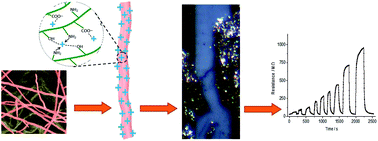Micro-sensors based on hypha-templated coaxial microfibers†
Abstract
Biological templates show great potential in the fabrication of advanced materials since they are green, renewable and easy to obtain. Hyphae of Penicillium are demonstrated to be a versatile template for the fabrication of coaxial microfibers. Five kinds of nanomaterials, including ZnO, Fe3O4, Cu(OH)2, polypyrrole (PPy) and polyaniline (PANI), are coated on the hyphal surface without any modification. SEM, EDS, XRD and FT-IR were employed to confirm the morphology and chemical components of the prepared microfibers. The results showed that the fabricated nanomaterials were attached firmly on the hyphal surface to form an outside shell. An adsorption experiment showed that the cations could be attached on the hyphal surface with the help of related functional groups, which explained well the formation mechanism of the coaxial structure. Microsensors based on PANI/hypha, PPy/hypha and ZnO/hypha microfibers were fabricated and tested with TMA as the model gas. The prepared sensors showed a good linear response toward TMA with an R2 higher than 0.977, relative standard deviation for reproducibility measurement lower than 7.2%, and fast response–recovery speed, which demonstrate the applicability of the prepared coaxial microfibers.



 Please wait while we load your content...
Please wait while we load your content...